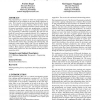Free Online Productivity Tools
i2Speak
i2Symbol
i2OCR
iTex2Img
iWeb2Print
iWeb2Shot
i2Type
iPdf2Split
iPdf2Merge
i2Bopomofo
i2Arabic
i2Style
i2Image
i2PDF
iLatex2Rtf
Sci2ools
ESEM
2008
ACM
2008
ACM
Pair programming: what's in it for me?
Pair programming is a practice in which two programmers work collaboratively at one computer on the same design, algorithm, or code. Prior research on pair programming has primarily focused on its evaluation in academic settings. There has been limited evidence on the use, problems and benefits, partner selection, and the general perceptions towards pair programming in industrial settings. In this paper we report on a longitudinal evaluation of pair programming at Microsoft Corporation. We find from the results of a survey sent to a randomly selected 10% of engineers at Microsoft that 22% pair program or have pair programmed in the past. Using qualitative analysis, we performed a large-scale card sort to group the various benefits and problems of pair programming. The biggest perceived benefits of pair programming were
Biggest Perceived Benefits | ESEM 2008 | Large-scale Card Sort | Pair Programming | Software Engineering |
| Added | 19 Oct 2010 |
| Updated | 19 Oct 2010 |
| Type | Conference |
| Year | 2008 |
| Where | ESEM |
| Authors | Andrew Begel, Nachiappan Nagappan |
Comments (0)

